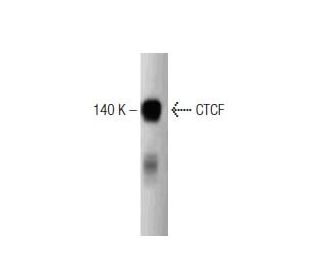


CTCF Antibody (48): sc-136284
- CTCF Antibody (48) is a mouse monoclonal IgG1 provided at 50 µg/0.5 ml
- raised against amino acids 184-290 of CTCF of human origin
- recommended for detection of CTCF of mouse, rat and human origin by WB, IP and IF
- At present, we have not yet completed the identification of the preferred secondary detection reagent(s) for CTCF Antibody (48). This work is in progress.
QUICK LINKS
SEE ALSO...
CTCF Antibody (48) is a mouse monoclonal IgG1 antibody that detects CTCF in mouse, rat, and human samples through applications such as western blotting (WB), immunoprecipitation (IP), and immunofluorescence (IF). CTCF, a member of the zinc finger transcription factor family, plays a crucial role in gene regulation by recognizing long and diverse DNA sequences, which is essential for the proper expression of numerous genes. The DNA-binding domain consists of 11 zinc fingers, including 10 of the C2H2 class and 1 of the C2HC class, which are highly conserved across vertebrate species, underscoring evolutionary significance. CTCF functions not only as a repressor of the c-myc gene but also as a key regulator of lysozyme gene expression. Additionally, CTCF interacts with the essential activator domain in the promoter region of the amyloid beta-protein precursor (APP) gene, facilitating APP transcription, which is vital for synapse formation between primary neurons during development. Ubiquitous expression of CTCF in the nucleus highlights importance in cellular processes, while regulation through differential phosphorylation and changes in mRNA and protein levels during terminal differentiation illustrates the complexity of function in gene expression control. Anti-CTCF antibody (48) serves as an invaluable tool for researchers studying gene regulation and cellular differentiation.
Alexa Fluor® is a trademark of Molecular Probes Inc., OR., USA
LI-COR® and Odyssey® are registered trademarks of LI-COR Biosciences
CTCF Antibody (48) References:
- Targeted Degradation of CTCF Decouples Local Insulation of Chromosome Domains from Genomic Compartmentalization. | Nora, EP., et al. 2017. Cell. 169: 930-944.e22. PMID: 28525758
- The structural basis for cohesin-CTCF-anchored loops. | Li, Y., et al. 2020. Nature. 578: 472-476. PMID: 31905366
- Promoter-proximal CTCF binding promotes distal enhancer-dependent gene activation. | Kubo, N., et al. 2021. Nat Struct Mol Biol. 28: 152-161. PMID: 33398174
- Jpx RNA regulates CTCF anchor site selection and formation of chromosome loops. | Oh, HJ., et al. 2021. Cell. 184: 6157-6173.e24. PMID: 34856126
- CTCF shapes chromatin structure and gene expression in health and disease. | Dehingia, B., et al. 2022. EMBO Rep. 23: e55146. PMID: 35993175
- MYC reshapes CTCF-mediated chromatin architecture in prostate cancer. | Wei, Z., et al. 2023. Nat Commun. 14: 1787. PMID: 36997534
- CTCF is a DNA-tension-dependent barrier to cohesin-mediated loop extrusion. | Davidson, IF., et al. 2023. Nature. 616: 822-827. PMID: 37076620
- CTCF and R-loops are boundaries of cohesin-mediated DNA looping. | Zhang, H., et al. 2023. Mol Cell. 83: 2856-2871.e8. PMID: 37536339
- G-quadruplexes associated with R-loops promote CTCF binding. | Wulfridge, P., et al. 2023. Mol Cell. 83: 3064-3079.e5. PMID: 37552993
- CTCF coordinates cell fate specification via orchestrating regulatory hubs with pioneer transcription factors. | Liu, Y., et al. 2023. Cell Rep. 42: 113259. PMID: 37851578
Ordering Information
| Product Name | Catalog # | UNIT | Price | Qty | FAVORITES | |
CTCF Antibody (48) | sc-136284 | 50 µg/0.5 ml | $316.00 |
